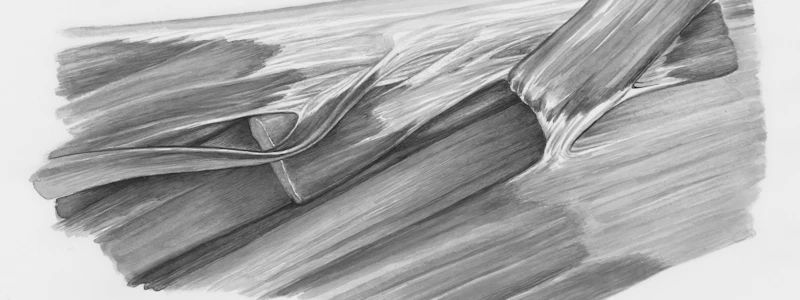Podcast
Questions and Answers
What are Peyer's Patches?
What are Peyer's Patches?
Lymphatic nodules residing in the small intestines.
What are the two types of phagocytes?
What are the two types of phagocytes?
Macrophage and Neutrophils.
What is a Macrophage?
What is a Macrophage?
An important phagocyte that remains fixed in strategic areas.
What are Neutrophils?
What are Neutrophils?
What is the body's largest lymphatic organ?
What is the body's largest lymphatic organ?
What are the functions of the spleen?
What are the functions of the spleen?
The spleen lies in the upper ________________ quadrant of the abdomen.
The spleen lies in the upper ________________ quadrant of the abdomen.
The spleen is structurally similar to the ________________________.
The spleen is structurally similar to the ________________________.
Lymphocytes and Macrophages in the _________________ pulp screen the passing blood for foreign antigens.
Lymphocytes and Macrophages in the _________________ pulp screen the passing blood for foreign antigens.
Macrophages in the _________________ remove the digest worn-out blood cells.
Macrophages in the _________________ remove the digest worn-out blood cells.
The spleen stores what percentage of the body's platelets?
The spleen stores what percentage of the body's platelets?
The spleen produces ____________________ in the fetus.
The spleen produces ____________________ in the fetus.
When a phagocyte encounters a microorganism, it sends out membrane projections called ________________.
When a phagocyte encounters a microorganism, it sends out membrane projections called ________________.
What are Lymph Nodes?
What are Lymph Nodes?
What do Tonsils consist of?
What do Tonsils consist of?
What is the Thymus?
What is the Thymus?
What is Lysozyme?
What is Lysozyme?
What is IgG?
What is IgG?
What do Helper T Cells do?
What do Helper T Cells do?
The immune process begins when a _____________________ ingests an antigen.
The immune process begins when a _____________________ ingests an antigen.
Called an __________________________, this displays fragments of the antigen on its surface.
Called an __________________________, this displays fragments of the antigen on its surface.
This process is called _______________, which alerts the immune system to the presence of a foreign antigen.
This process is called _______________, which alerts the immune system to the presence of a foreign antigen.
When a ______________ spots the foreign antigen, it binds to it.
When a ______________ spots the foreign antigen, it binds to it.
This activates (or sensitizes) the __________, which begins dividing repeatedly to form clones.
This activates (or sensitizes) the __________, which begins dividing repeatedly to form clones.
Some of these cells become __________________________ (such as __________________________ cells and ______________________ cells), which will carry out the attack.
Some of these cells become __________________________ (such as __________________________ cells and ______________________ cells), which will carry out the attack.
The _______________________________________ cell binds to the surface of the antigen and delivers a toxic dose of chemicals that will kill it.
The _______________________________________ cell binds to the surface of the antigen and delivers a toxic dose of chemicals that will kill it.
___________________________________ cells support the attack by secreting the chemical ________________________, which attracts neutrophils.
___________________________________ cells support the attack by secreting the chemical ________________________, which attracts neutrophils.
It also stimulates the production of ____ and _____ cells.
It also stimulates the production of ____ and _____ cells.
Flashcards are hidden until you start studying
Study Notes
Peyer's Patches
- Lymphatic nodules found in the small intestines, involved in immune monitoring.
Phagocytes
- Two primary types: Macrophages and Neutrophils play essential roles in the immune response.
Macrophages
- Crucial fixed phagocytes located strategically throughout the body for effective immune function.
Neutrophils
- Mobile phagocytes that rapidly gather at sites of acute injury to combat infections.
Spleen
- Largest lymphatic organ in the body, rich in lymphocytes, integral to immune function and blood maintenance.
Functions of the Spleen
- Immunity: Filters blood to remove pathogens.
- Destruction of Old Red Blood Cells: Responsible for recycling cellular components.
- Blood Storage: Reservoir for blood.
- Hematopoiesis: Produces blood cells in fetuses.
Spleen Location
- Positioned in the upper left quadrant of the abdomen.
Structural Similarity
- The spleen bears a resemblance to lymph nodes in its organization and function.
White Pulp
- Contains lymphocytes and macrophages that filter blood for foreign antigens.
Macrophage Activity
- Located in sinuses, they digest and remove old blood cells and debris.
Platelet Storage
- Approximately 20% to 30% of the body's platelets are stored in the spleen.
Fetal Development
- Produces red blood cells in the fetus, supporting early life.
Pseudopods
- Extensions of the membrane of phagocytes used to engulf microorganisms.
Lymph Nodes
- Kidney-shaped structures compose the lymphatic system and filter lymphatic fluid.
Tonsils
- Aggregations of lymphoid tissue that create a protective circle at the back of the throat against pathogens.
Thymus
- A lymphoid organ where T cells mature, situated in the mediastinal cavity.
Lysozyme
- Enzyme present in immune cells that destroys bacteria, contributing to the immune response.
IgG Antibodies
- The most abundant immunoglobulin, constituting 80% of circulating antibodies, key in secondary immune responses.
Helper T Cells
- Facilitate the immune response by supporting other immune cells.
Antigen Recognition
- Immune process begins with phagocytes ingesting antigens, leading to an antigen presentation to T cells.
T-Cell Activation
- Antigen-presenting cells display antigen fragments to T cells, triggering their activation and clonal expansion.
Effector Cells
- Some activated T cells differentiate into cytotoxic T cells and helper T cells, responsible for attacking pathogens.
Cytotoxic T Cells
- Directly kill infected cells by binding to their surfaces and delivering toxic chemicals.
Helper T Cell Function
- Secrete interleukins that help attract other immune cells (neutrophils, natural killer cells) and stimulate B and T cell production.
Studying That Suits You
Use AI to generate personalized quizzes and flashcards to suit your learning preferences.




